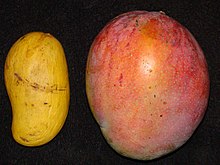Ataulfo (mango)
| Mango 'Ataúlfo' | |
|---|---|

Ataulfo mango (left), Tommy Atkins (right)
|
|
| Genus | Mango |
| Cultivar | 'Ataúlfo' |
| Origin | Mexico |
The Ataúlfo, also called young, baby, yellow, honey, Adaulfo, Adolfo, or Champagne is a mango cultivar from Mexico. Ataulfo mangos are golden yellow and generally weigh between 6 and 10 ounces (170 and 280 g), with a somewhat sigmoid (oblong) shape and a gold-blushed yellow skin. Their buttery flesh is not fibrous, and they have a thin pit. Their flesh is a deep yellow and high in sugar (15 grams per 100-gram serving), with a rich, sweet flavor. They were named for grower Ataulfo Morales Gordillo.
The Mexican Institute of Industrial Property (Instituto Mexicano de la Propiedad Industrial) granted the designation of origin of this fruit to the government of Chiapas.
In 1958, the agronomist Hector Cano Flores (the discoverer of Ataulfo mango) reportedly made a clone of an Ataulfo mango which he named IMC-M2.
In 2003, the Mexican government, through the Official Gazette, published Comunicado No. 14 – 2003 titled “Abstract of the application for the declaration (protection) of the Appellation of Origin: Mango Ataulfo del Soconusco Chiapas,” a declaration that the term “Mango Ataulfo del Soconusco Chiapas” is an appellation of origin for a specific kind of mango fruit produced in several regions of Chiapas, Mexico where the Ataulfo was first grown by Ataulfo Morales Gordillo.
The fruit grows in warm, moist climates with summer rains, but monsoon temperatures must not decline to 41 °F. The proper temperature for this type of mango is 83 °F with rainfall between 1090–3000 mm annually, from April to October.
The Ataulfo mangoes originate in the Mexican states of Michoacan, Sinaloa, Nayarit, Jalisco, Veracruz and Chiapas, and are sold between March and September. In the Mexican state of Chiapas, mango production was, as of 2008, the sixth most important agricultural activity, based on cultivated surfaces, following corn, beans, coffee, sugar cane and cocoa. Ataulfo production in that state was concentrated in the Soconusco coastal region. Overall, producer organizations estimated that there were 18,000 hectares of Ataulfo mangoes in production in the state.
Ataulfo mangoes gained popularity in the United States beginning in the late 1990s, though they have been a major crop in Mexico for decades. As of 2009, they were the second-most popular variety of mango sold in the United States, behind the Tommy Atkins.
...
Wikipedia
